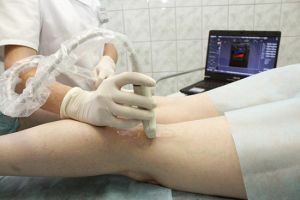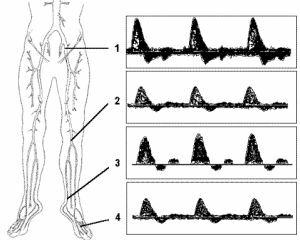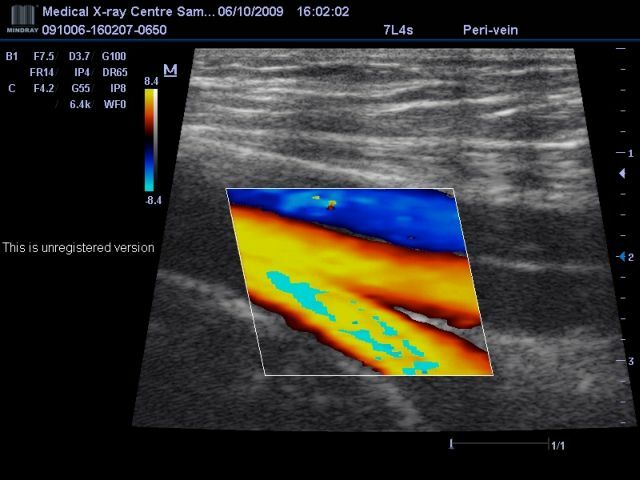 Special attention at any age should be given to their vessels, therefore a person who takes care of his health is probably familiar with such procedure as ultrasound dopplerography or ultrasound.
Special attention at any age should be given to their vessels, therefore a person who takes care of his health is probably familiar with such procedure as ultrasound dopplerography or ultrasound.
This method allows you to quickly identify varicose veins, as well as concomitant diseases of veins and arteries, and also begin treatment at the earliest stages, which will avoid complications and preserve the beauty of the legs.
Ultrasound dopplerography is a procedure that allows performing complex investigation of arteries and veins, revealing existing disorders and various diseases at the earliest stages. At the heart of the study lies the familiar method of ultrasound, combined with Dopplerography.
Contents of
- Features and objectives of the
- study Indications for the
- procedure Preparation for diagnosis
- How do UZDGs?
- Results and transcription
- From the practice of patients in the
Clinic Features and objectives of the
Most often the doctor recommends the passage of the USDG procedure in order to confirm or disprove the existing violations of the blood vessels, therefore one should not try to pass it by itself - ultrasonic dopplerography of the vessels should become part of the diagnostic complexand the treatment of varicose veins and other diseases affecting the vessels, veins and blood circulation in general.
The research carried out by the method of ultrasound is carried out, primarily, on the vessels: 
- of the head, including the cervical spine;
- of the upper extremities( the veins in the problem zone are also being examined);
- of the kidney;
- of the lower extremities( also veins).
Allows you to effectively examine and obtain comprehensive information about the system of venous and arterial blood circulation.
Today, a variety of techniques based on ultrasound with the use of the Doppler effect are of great interest among patients, because they allow you to begin the treatment process sooner.
UZDG allows, in particular, to determine the condition of the wall of the lumen of the vessels, and also in real time to register the parameters of the blood flow, which will allow the specialist to deliver an accurate and error-free diagnosis.
The peculiarities of this modern procedure is that it is possible to obtain information on the state of vessels based on measurements of reflections of sound waves emerging from moving objects.
The data is processed using computer technology, resulting in a two-dimensional color image of the blood vessel system of the patient being examined. Sites that need special attention from doctors are shown on it separately. This makes it possible for doctors to understand in which areas there are difficulties in the flow of blood.
Dopplerography provides an opportunity to identify problems such as:
- arterial stenosis;
- various disorders in the state of the vascular walls;
- tortuosity;
- disturbed arterial and venous blood flow.
 The specialist will be able to quickly determine not only the problem, but also identify the cause of its occurrence. In general, UZDG allows you to comprehensively study only one, but very important for the stable functioning of the entire body function - the permeability of the vessel, it is determined based on the flow of blood.
The specialist will be able to quickly determine not only the problem, but also identify the cause of its occurrence. In general, UZDG allows you to comprehensively study only one, but very important for the stable functioning of the entire body function - the permeability of the vessel, it is determined based on the flow of blood.
The procedure is performed blindly, the sensor of the device is placed on the points from which an approximate projection of the vessel research will be constructed. If any, even weakly expressed violation of the patency of the vessel is detected, this will be noticeable.
Indications for the procedure
It is necessary to undergo a procedure using the technique of dopplerography of cerebral vessels in the following cases of deterioration of well-being:
- headaches are various in intensity, including migraines;
- dizziness that occurs in various situations and for no apparent reason, for example, with a turn of the head or without physical exertion;
- ringing and intense noise in the ears and head;
- loss of consciousness, including episodic;
- "black" points in front of the eyes;
- weakness in the body;
- numbness of the limbs;
- heart disease.
Dopplerography of the vessels of the lower extremities is indicated for various kinds of varicose disorders.
No contraindications to the procedure were found. There are only temporary limitations caused by the fact that a patient other than  can lie or his general condition is very difficult.
can lie or his general condition is very difficult.
This technique is absolutely safe and will not cause harm to the body. It will provide high information content in the early stages of development of various changes and pathological processes, allowing the specialist to make a diagnosis on time and accurately and promptly begin the necessary treatment.
This study of vessels does not cause side effects, there is no radiation load on the body. For maximum diagnostic efficiency, it is advisable to undergo examination at once, as there were problems with health.
Preparation for diagnosis
Preparatory procedures do not require much personal time. All that is required of the patient:
- to adopt a horizontal position;
- relax;
- does not move during the procedure.
In addition, the preparation for the study assumes that the patient will need to undress beneath the waist, only the underwear remains.
After this, the doctor conducting the study applies a special gel that will allow better contact of the sensors with the site to be diagnosed. It is important - the legs should be divorced to the width of the shoulders, the feet slightly divorced in the sides.
Sometimes you need to get up so that in the process of research the doctor could determine how the vessels undergoing physical exertion behave.
How are UZDG done?
Immediately the scanning process is that the doctor slowly drives the sensor over the skin area, on the monitor at this time  appear the corresponding graphic images containing all the necessary information about the pathological and anatomical changes taking place in the vessels of the venous leg system. Also, the images make it clear if there are functional changes in the blood flow.
appear the corresponding graphic images containing all the necessary information about the pathological and anatomical changes taking place in the vessels of the venous leg system. Also, the images make it clear if there are functional changes in the blood flow.
Based on the results of the study, the specialist determines the further treatment regimen. Previously, he studies the changes that have occurred in the anatomical structure of the veins and the violation of their functions.
Thus, the doctor develops a diagnostic examination and prescribes preventive or curative procedures that will be most effective in a particular case.
Results and transcript
As a result of a survey conducted using this technique, an opinion is obtained about the uniformity or existing disorders in the blood flow. Also, an opinion is given on the types of violations. The presence of pathologies is determined, in particular, by the narrowing of the vessels. The procedure will reveal clogs resulting from the formation of a thrombus.
Changes in the vessels that occurred during the inflammatory process will also be recognized during the examination. The doctor fully estimates the structure of the vessels of the extremities, their tortuosity, aneurysms and kinks.
Various changes and anomalies in the structure of veins are effectively detected, spasms of arteries are recognized in various degrees of their manifestation.
As a result of the study, the doctor is able to determine the probability of squeezing the vessels, which can be caused by external scars or muscle spasms. The procedure with great accuracy shows the patency and location of all the arteries and veins present in the zone of attention.

The result of the study, on the basis of which the conclusion about the patient's condition is made, the doctor writes down the numbers. The following are subject to assessment:
- location of sites in vessels in which, in the opinion of the physician, changes occurred;
- degree of disturbance of natural blood flow;
- permeability of veins;
- operation of all valves.
Evaluation of the results of the procedure is also recorded with the help of letters. So the maximum velocity of blood flow passing in the femoral artery is 100 cm / s, while at the same time this figure in the calf region is 50 cm / s.
The type of blood flow for the femoral artery with normal indices of its operation is called the main one. Accordingly, if there are other indicators in the conclusion, then there are changes and violations that need to be treated.
From the practice of patients of clinics
Reviews, people who had ultrasound dopplerography of vessels of lower extremities.
I began to feel some changes in my state of health two years ago - a simple physical load caused a lot of trouble, including fatigue and pain in the legs. Then I began to feel that they were swelling. The increase in size was visible to the naked eye.
I learned about the research technique similar to ultrasound on a doctor's appointment, which was promptly applied. The study itself took no more than 20 minutes - this with all the preparatory elements. The doctor was able to quickly diagnose, based on the results.
The treatment was also made very quickly, so the recovery program began working almost immediately after treatment. Today I can easily perform many jobs that require physical activity. I believe that it was this method that allowed us to return to our old, active and active life. My recommendations.
Svetlana, 36
My work is connected with large and long loads, so I was not even surprised. That one day began to feel that in the legs there was at first a slight fatigue after the end of the shift, and then pain was added to it.
I did not attach any attention, but after I felt numbness one day, I decided to see a doctor. He directed me to the procedure of UZDG, which passed quickly.
I admit, I thought that it would not give a special result, but the received treatment program restored the former endurance after several weeks of treatment. I am very pleased that I have been examined by UZDG and started treatment at early stages.
Stanislav, 41
The cost of the procedure in Russia starts from 800 rubles. Timely passing the diagnosis will not only quickly develop an effective program of treatment and rehabilitation, but also avoid the unpleasant consequences of complications.
